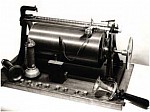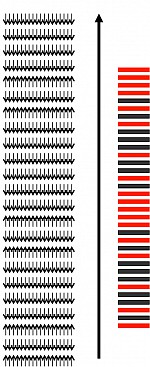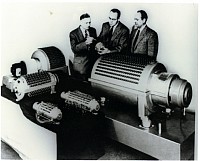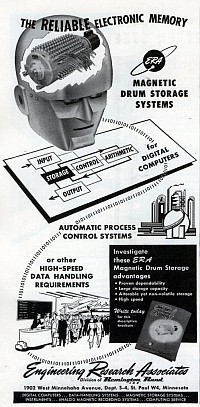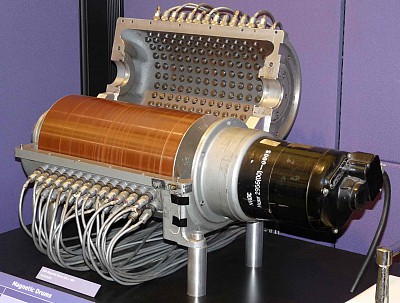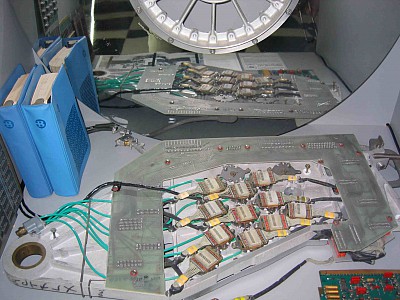Computer Science
Computing History Displays: Fifth Floor - Magnetic Data Storage - Early Days
In the late 1940s, when the designers of the first computers needed to provide fast storage and retrieval of digital data they could draw on the technology for recording analog audio information using magnetism that had been developed over the preceding 50 years. The concept behind the technology was outlined by the American Oberlin Smith in 1878 and publicized more-widely 10 years later.
However, it was not until 1898 that the first functioning magnetic recorder, the telegraphone, was demonstrated by the Danish inventor Valdemar Poulsen. The technology developed slowly during the first part of the 20th century for use in dictaphones, for telephone message recoding and for delayed radio broadcasting. The magnetic media were steel wires and steel tapes (though there were devices that used disks following the same format as gramophones.) Major breakthroughs were made in the 1930s with the use of coated plastic tapes - by the early 1940s the German tape recorders called magnetophones were being used to make high-quality orchestral recordings.
Representation of digital information needs two states only. Thus only two directions of magnetization are used, let us say SN or NS in the direction of motion (the medium can also be magnetized "vertically" - this improvement will be discussed later). The medium comprises a backing material which has a thin coating that adopts the magnetization that is applied to it. To write bits of information, the medium is moved past a recording head that is a tiny electromagnet. By changing the direction of current in the magnet's wiring, the medium is magnetized in one direction or the other along the track (sometimes, particularly with video-based devices, the head is moved as well so it is relative motion.) The track width is usually wider than the displacement representing a bit so the magnetized area is a bar, but unlike the popular bar magnet is magnetized across its short axis.
The earliest digital magnetic stores used induction to read the information stored. The medium is moved past a "read head" which is an electromagnet used "in reverse" (sometimes the same as the "write head"). A change in magnetization direction induces a current in the electromagnet's wires. In modern devices the magnetization is sensed by other means but the tradition is maintained that the two states of raw bits are represented by a transition or no transition in the direction of magnetization.
There are problems with this representation among which is that the length of a sequence of non-transitions might be hard to determine accurately because of slight variations in the speed of the medium. These problems can be overcome by having special "timing" tracks, pre-recorded with a sequence of 1s, that are read at the same time as the data. However most commonly the data is "self clocking" - it is recoded so that long sequences of non-transitions are avoided so that the boundaries between bits can be determined accurately. (the simplest encoding "FM" - 1 is TT and 0 is TN (T - transition, N - no T.)) This significantly reduces recording density and is now replaced by other schemes such as "Run Length Limited" (RLL) encoding - e.g. RLL 2,7 (where the maximum run length of Ns in the encoding is 7 and the minimum is 2.)
Drums as Computer Memories
Computers as proposed by von Neumann and Turing required memory that would contain both data and programs. The memory had to be fast (operate at electronic speeds) and random access (take the same time for each word in the memory). Although the technology for processing data electronically was available from the mid 1940s there was no matching technology for computer main memory. This did not really become available until the development of magnetic core memory in the mid to late 1950s.
In the interim use was made of memories that were available but which lacked some of the desirable properties. One possibility was to use magnetic data storage. This was of reasonable price and capacity but had the defect that it was slow and not truly random access - some data items took longer than others to access. (Acoustic delay lines, also used in early computers, had similar properties.) .
The first magnetic data stores used information stored on the surface of drums rather than disks. Drums were easier to design with the required tolerances and there was room to provide read/write heads for each track staggered around the drum. There was thus no head movement to control which made the maximum access time quite short - one revolution of the drum. With multiple heads data could be transferred "word parallel" so data transfer rates could be quite high compensating for the slow, non-random access.
The first drum development was started in the USA in 1946 with the founding of Engineering Research Associates operating out of St Paul, Minnesota. ERA performed research and development work for the US Navy (actually for cryptographic applications.) Two of the first working drums were delivered in 1948, but their first drum for a computer to use as main memory was for the Atlas computer delivered in 1950. (The was the first of at least three computers named Atlas - this one was named after a comic-strip character.)
The Atlas drum was 8.5 ins. diameter, 14 ins. long, stored 16384 24-bit words at a density 80 bits per inch along the track , rotated at 3450 rpm, giving an access time of 17ms. This computer was funded as project number 13 for ERA so the commercial version was given the binary name of "ERA 1101" as an insider's joke. ERA was later rolled into Univac Corporation and its successor computers given names 110x - up to the 1108 in the 1970s. ( The first Wanganui police computer in New Zealand was one of this series.) Below is an ERA drum in the collection of the Computer History Museum, California.
ERA also designed a drum for the IBM 650, the first computer in NZ, which was of the same genre as the ERA 1101. (The 650 drum was 4 in diameter, 16 in long, 12,500 rpm, 4.8 ms max, 1000-2000 decimal digits encoded in the abacus-like biquinary code.) Although computers like the IBM 650 were slow they received a boost by having each instruction specify the address of the next. Thus, with knowledge of instruction timing it could be arranged that the next instruction was immediately available under the read heads. This optimization and cleaning-up was done by software, in the case of the IBM 650 by the Symbolic Optimizing Assembly Program - SOAP!
Magnetic drums were also researched at the University of Manchester in England and developed as a commercial product by Ferranti for their Mark 1 computer. (The Ferranti Mark 1 drum was 10 in diameter and 12 in long, stored 16384 40-bit words serially at 200 rpm, with maximum 30ms access time.) . The Manchester drums had a different use - rather than being the computer's fastest memory they were used to supplement a real parallel memory and extend its capacity. They accessed data serially rather in parallel as it was more appropriate for this application.
The use of drums as main memory died out with the arrival of core memories but their use as a fast back-up or extension to fast memory remained. They were used to implement virtual memory or paging systems where the addressable main memory is much larger than the actual main memory. Drums were taken further, particularly by Univac, but the technology with momentum was the hard disk and this gradually replaced the drum. For use in paging, some disks were provided with one "head per track" (such as in the B6700 disk on display) or some fixed heads were provided on otherwise conventional disks. Special paging stores continued to be made up until the late 1970s but this role was eventually taken over by ordinary disks as they, and the capacity of regular main storage, improved.


